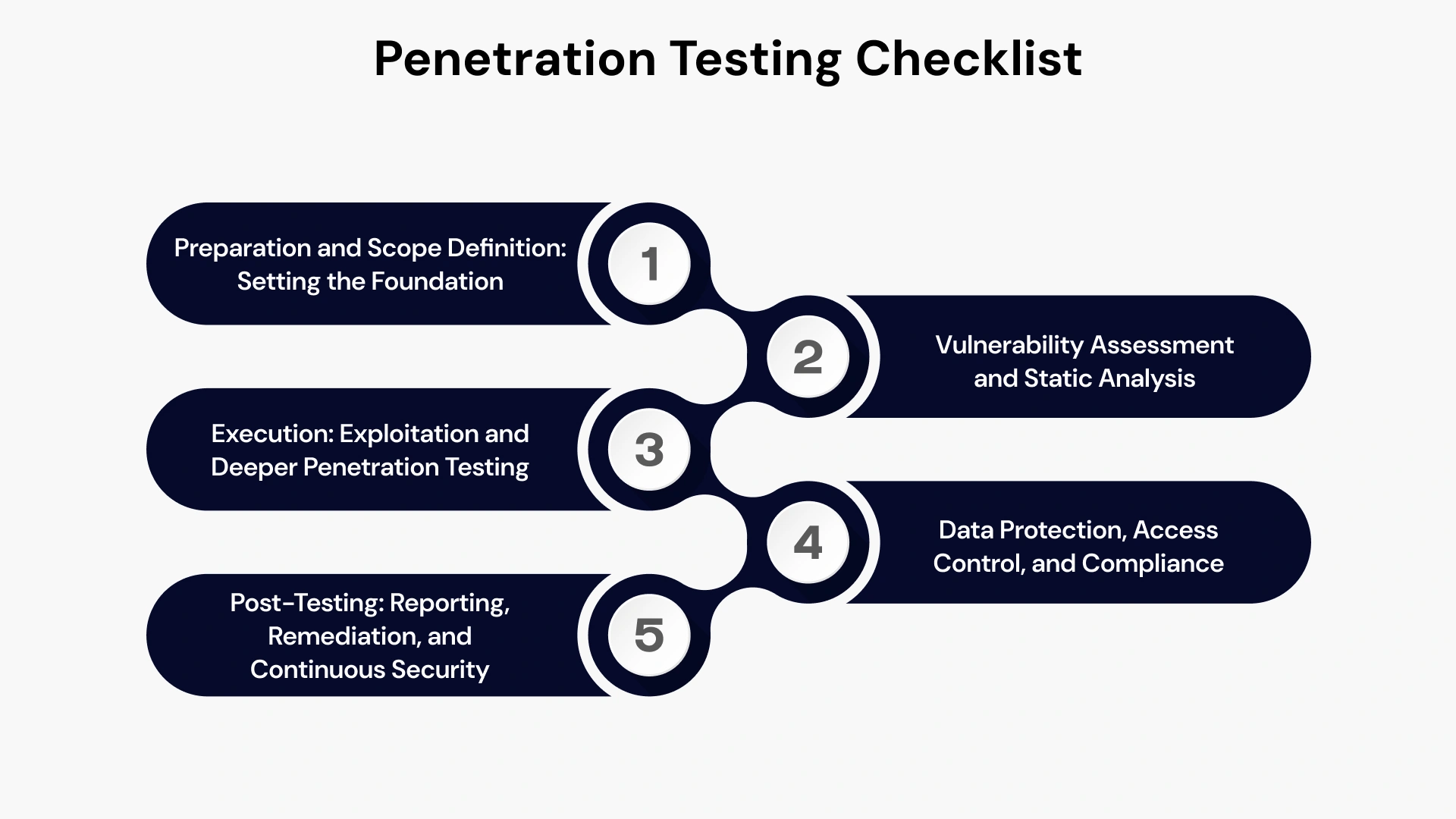Rigorous security testing, specifically high-quality penetration testing, forms the foundational layer of defense for companies that provide financial software development services. This essential practice directly impacts regulatory adherence, system resilience, and, critically, customer trust.
This blog guide offers a comprehensive, step-by-step penetration testing checklist to help achieve success in fintech. It is designed to empower your team to go beyond basic checks and implement a robust, continuous security posture that will help your company excel in security and compliance standards.
The Fintech Security Imperative: Why Penetration Testing Matters
In the fintech industry, the data handled—from personal identifiers to transactional records and sensitive financial information—is among the most valuable to attackers. A security failure not only leads to catastrophic financial losses but also invites severe regulatory penalties and irreparable damage to a company's reputation.
Penetration testing in the fintech industry simulates real-world attacks to expose exploitable flaws in an application design, code, and infrastructure before malicious actors can find and leverage them. This proactive approach elevates the quality of your financial software development services and significantly reduces your fintech risk assessment process exposure.
Key Benefits of Proactive Fintech Penetration Testing:

- Protects Core Assets: Safeguards sensitive customer data, payment systems, and proprietary financial software from unauthorized access and breaches.
- Ensures Regulatory Compliance: Provides the necessary evidence for mandatory audits, helping to satisfy complex requirements such as PCI DSS compliance for fintech apps, SOC 2, and other financial regulations.
- Boosts Customer Confidence: Demonstrates a commitment to security, which is paramount for maintaining customer trust and a strong company reputation in the sensitive fintech industry.
- Improves Code Quality: Identifies flaws early, promoting the adoption of secure coding practices in fintech development lifecycles.
- Minimizes Financial and Operational Impact: Proactive testing significantly reduces the costly downtime, incident response expenses, legal fees, and potential fines associated with a significant breach, safeguarding business continuity for financial software development services.
- Enhances System Resilience and Future-Proofing: By simulating real-world attacks and identifying architectural weaknesses, it strengthens the overall fintech cybersecurity framework, making systems more resilient against emerging, sophisticated threats and improving the long-term effectiveness of the fintech risk assessment process.
Penetration Testing Checklist for Fintech Success
A successful fintech penetration testing engagement requires meticulous planning, expert execution, and systematic follow-up. The following structured fintech security testing checklist ensures that all critical components are assessed, providing comprehensive coverage for both established institutions and fintech startups.

1. Preparation and Scope Definition: Setting the Foundation
Before any testing begins, precise definition and planning are crucial. This stage aligns the test with business objectives and regulatory needs.
Step | Action Item | Relevance to Fintech Security |
1.1 | Define Scope and Inventory Assets | Document all systems: fintech web application security testing, mobile banking app security testing, APIs, cloud assets, and third-party integrations. Prioritize critical financial functions. |
1.2 | Establish Objectives and Compliance Criteria | Align testing with specific regulatory mandates (e.g., PCI DSS, SOC 2, ISO 27001). Set measurable goals for improving your security posture. |
1.3 | Planning and Reconnaissance | Map all business logic, transaction flows, and sensitive data storage points. Gather public information (domains, IP ranges, cloud details) to inform the subsequent fintech vulnerability assessment. |
1.4 | Agree on Methodology | Determine the appropriate testing methods (black-box, white-box, gray-box) for varied fintech threat modeling scenarios. |
2. Vulnerability Assessment and Static Analysis
This stage involves a systematic scan and analysis to discover known weaknesses, moving from broad strokes to granular code examination.
Step | Action Item | Relevance to Fintech Security |
2.1 | Automated Vulnerability Scanning | Scan networks and applications using automated tools (like OWASP ZAP, Burp Suite, Nessus). Focus on the OWASP security checklist for fintech and common financial threats. |
2.2 | Static Application Security Testing (SAST) | Use SAST tools to analyze source code for insecure design flaws and secure coding practices in fintech applications without executing them. Integrate this with Quality Assurance Services. |
2.3 | Software Composition Analysis (SCA) | Check out all third-party dependencies, open-source libraries, and frameworks for known vulnerabilities, as these are common entry points for attacks on financial software security testing. |
2.4 | Configuration Analysis | Review server, network, and cloud configurations for mismanagement, default settings, and overly permissive access. |
3. Execution: Exploitation and Deeper Penetration Testing
The core of fintech penetration testing involves actively attempting to exploit the weaknesses found, simulating the techniques of a real attacker.
3.1 Web Application Security Testing
Focus on the user-facing and admin panels of the web application, adhering strictly to the OWASP security checklist for fintech.
- Authentication & Session Management: Test for weak passwords, lack of MFA enforcement, session fixation, and insecure token handling.
- Injection Flaws: Rigorously test for SQL, Command, and Cross-Site Scripting (XSS) vulnerabilities, which are critical threats to any platform offering financial software development services.
- Business Logic Flaws: Test vulnerabilities specific to the application's unique features, such as transaction reversal exploits, rate limit bypasses, and unauthorized fund transfers. This is key to a high-quality fintech app pentesting guide.
3.2 Mobile Banking App Security Testing
A dedicated focus on mobile platforms (iOS and Android) is essential for any modern fintech app to adhere to the best security practices.
- Insecure Data Storage: Check for sensitive information (credentials, tokens, session data) stored insecurely on the device.
- Client-Side Injection: Test for client-side manipulation, bypassing root/jailbreak detection, and overlaying attacks.
- Reverse Engineering: Assess the application’s resilience against static and dynamic analysis and code tampering.
3.3 Fintech API Penetration Testing
API endpoints are the backbone of modern fintech industry services, connecting everything from payment gateways to user accounts. They require specific, detailed testing.
- Rate Limiting: Test the ability to send massive volumes of requests, which could lead to service disruption or enumeration of user data.
- Data Exposure: Ensure APIs do not leak sensitive PII or system information in responses or error messages.
3.4 Network and Infrastructure Security Testing
This validates the environment hosting financial software security testing.
- External and Internal Network Tests: Check firewalls, routers, load balancers, and segmentation rules. Run periodic fintech infrastructure security audits to identify cloud misconfigurations or outdated servers.
- Wireless Security: Audit Wi-Fi networks used by staff for weak protocols or lack of segregation from the production network.
4. Data Protection, Access Control, and Compliance
This section of the fintech cybersecurity checklist verifies the controls that safeguard highly sensitive financial data.
Step | Action Item | Relevance to Fintech Security |
4.1 | Data Encryption and Access Control | Confirm strong encryption standards (TLS 1.2+ for transit, AES-256 for rest). Verify the proper storage and rotation of encryption keys, ideally in a Hardware Security Module (HSM). |
4.2 | Authentication, Authorization, and Access Control (A3) | Enforce and rigorously validate Multi-Factor Authentication (MFA) for all users and staff. Test Role-Based Access Controls (RBAC) to ensure users can only access the minimum data necessary to perform their job. |
4.3 | Third-Party Integration Testing | Test the security of all 3rd party integrations, including payment gateways, KYC/AML providers, and core banking systems. These are significant vectors for a successful fintech vulnerability assessment. |
4.4 | Compliance and Regulatory Audits | Maintain detailed evidence and logs to demonstrate that the application meets the mandatory PCI DSS compliance requirements for fintech apps, data privacy regulations (e.g., GDPR), and operational security standards (SOC 2). |
5. Post-Testing: Reporting, Remediation, and Continuous Security
The value of penetration testing for financial applications is realized only when findings are acted upon and integrated into a sustained security process.
Step | Action Item | Relevance to Fintech Security |
5.1 | Reporting and Stakeholder Communication | Produce clear, actionable pentest reports for technical teams and executive summaries for business stakeholders. The report must provide an overview of the quantifiable fintech risk assessment process. |
5.2 | Incident Response and Patch Management | Validate the company’s ability to detect, respond to, and remediate a breach scenario. Promptly address and fix all critical and high-severity findings with a documented remediation and patch management process. |
5.3 | Retesting and Validation | After fixes are deployed, perform retesting to confirm that all identified vulnerabilities have been effectively closed and that new security gaps haven't been introduced. |
5.4 | Integration into DevSecOps | Integrate security checks (SAST, DAST) and Quality Assurance Services early into the development pipeline. This is a crucial element of a modern fintech cybersecurity framework. |
A successful penetration test in the highly regulated fintech industry is an investment in sustainable trust and operational maturity. By executing the above systematic penetration testing checklist for fintech, your organization establishes a verifiable defense mechanism, turning potential liabilities into documented proof of diligence.
This layered approach is critical for reliable financial software development services, but true security requires moving beyond general steps to targeted scrutiny. The following sections will outline how to tailor this core checklist to the unique requirements of specific technological components, such as APIs and mobile applications, thereby ensuring a comprehensive and resilient security posture for your business.
Sector-Specific Security Testing Recommendations
For penetration testing in the fintech industry, generic security checks are insufficient. A specialized approach is required to protect the integrity of financial transactions and sensitive data. This section outlines the key focus areas for a comprehensive fintech security testing checklist.
Web Application Security: Beyond the Basics
Web applications serve as the primary interface for many financial software development services. Testing must go beyond standard vulnerability scanning.
- OWASP Top 10 Focus: Meticulously follow the OWASP security checklist for fintech, paying specific attention to Injection Flaws, Broken Authentication, and Server-Side Request Forgery (SSRF).
- API Integration Points: Since web apps rarely operate in isolation, focus heavily on the security of every fintech API penetration testing endpoint called by the web front-end. This is often where business logic bypasses occur.
- Internal vs. Public Services: Regular fintech web application security testing must cover all public-facing services, as well as crucial internal administrative and reporting portals, which often hold higher privileges and sensitive data.
API Security: The Fintech Backbone
APIs are the transactional highways for modern fintech industry platforms. Dedicated fintech API penetration testing is crucial, as flaws in this area can be exploited to move funds or access data on a large scale.
- Robust Authentication and Authorization: Verify token validation, enforce strict authorization policies (checking who can access which data), and test for Broken Object Level Authorization (BOLA) and Broken Function Level Authorization (BFLA).
- Transaction Controls: Implement and test aggressive rate limiting on all transactional and data-querying endpoints to prevent brute-force attacks and enumeration.
- Secure Coding Practices: Ensure APIs in fintech adhere to secure coding practices by validating all inputs, minimizing data exposure in error messages, and utilizing proper logging for audit trails.
- Mobile Banking App Security: Protecting the Endpoint
The proliferation of mobile finance demands a specific fintech app pentesting guide that addresses both platform and application-level risks inherent to mobile banking app security testing.
- Data Storage and Integrity: Evaluate local data storage to ensure sensitive information (keys, tokens, PII) is never stored insecurely on the device.
- Client-Side Manipulation: Test the application's behavior on rooted/jailbroken devices and its resilience against reverse engineering, code tampering, and client-side logic manipulation.
- Secure Client-Server Interaction: Validate the integrity of data passed between the mobile app and the backend, focusing on session management flaws and secure channel enforcement (Certificate Pinning).
Compliance, Frameworks, and Standards
Adherence to industry-specific and regulatory standards is a core objective of all fintech security testing.
- Mandatory Compliance: PCI DSS compliance for fintech apps is a non-negotiable prerequisite for any entity handling cardholder data. The pentest must generate necessary evidence for these and other mandates (e.g., SOC 2, HIPAA if applicable).
- Security Framework Adoption: The use of internationally recognized standards, such as NIST SP 800-115 for security testing guidance and MITRE ATT&CK for simulating specific threat actor techniques, ensures your fintech cybersecurity checklist is comprehensive and globally recognized.
- Proactive Risk Management: Integrate fintech threat modeling at the design and architecture phase to proactively identify and mitigate risk. This structured approach informs the penetration test scope, leading to a more efficient fintech risk assessment process.
Best Practices for Penetration Testing in Fintech Companies
To maximize the return on investment from your security testing, integrate these advanced best practices for penetration testing in fintech companies into your operational workflow.

- Scheduled and Triggered Testing: Perform complete penetration testing in the fintech industry at least annually. More critically, testing should be triggered immediately after any major system upgrade, infrastructure change, or new product release to validate the security posture.
- Realistic Environment Testing: Test both production and staging environments, utilizing the staging environment for in-depth testing to minimize the impact on production. However, critical functions dealing with actual data flow should be validated in the production environment, where feasible and authorized.
- Aggressive Remediation & Retesting: Establish an aggressive Service Level Agreement (SLA) for fixing critical and high-severity findings. Rapid remediation, followed by mandatory retesting and validation, is a key indicator of a mature security program and vital for maintaining compliance.
- Cultivate a Security-Driven Culture: Implement social engineering awareness training, phishing simulations, and internal bug bounty programs to foster a culture of security awareness and vigilance. The human element often remains the weakest link; fostering a robust, security-driven culture among all staff, especially those providing financial software development services, is the ultimate defense against vulnerabilities.
Strategic Partnership: Choose VLink Expertise for Security Testing
Selecting the right partner for your penetration testing checklist for fintech is the most critical decision. The specialized nature of fintech vulnerability assessment demands a team with deep experience in financial regulatory compliance, complex transaction logic, and high-scale API architecture, particularly within the demanding US and Canadian markets.
VLink's specialized expertise provides a strategic advantage:
- Deep Fintech Specialization: Our certified security experts possess proven experience conducting penetration testing for financial applications, including mastery of complex financial protocols, payment gateways, and core banking systems.
- Compliance-Focused Methodology: We align every test with the requirements of PCI DSS compliance for fintech apps, SOC 2, and local US/Canadian financial regulations, ensuring your testing fulfills all auditing requirements.
- Comprehensive Coverage: Our services cover the full spectrum of your digital footprint—from fintech API penetration testing and mobile banking app security testing to cloud infrastructure audits and social engineering simulations.
- Actionable, Risk-Based Reporting: We provide clear, prioritized reports that move beyond simple vulnerability lists, offering strategic and technical remediation guidance that directly informs your development and Quality Assurance Services pipeline.
Partner with us to transform your security from a simple checklist item into a competitive advantage, securing your financial software development services for sustainable growth.
Conclusion: Securing the Future of Financial Services
The complexity and regulatory pressure of the fintech industry demands a world-class security program built on continuous improvement and proactive defense. This comprehensive penetration testing checklist for fintech provides the blueprint for securing your financial software development services, safeguarding customer trust, and ensuring continuous compliance across the demanding US and Canadian markets.
The transition from a reactive posture to a proactive, security-first mindset is the hallmark of leading fintech organizations. By implementing this detailed guide, you establish a resilient defense that protects your business today and positions you for sustainable growth tomorrow.
Ready to fortify your defenses and ensure compliance? For expert guidance on establishing a robust fintech cybersecurity checklist, executing a customized fintech risk assessment process, or implementing continuous security via financial software security testing, reach out today. Let our senior experts help you achieve best-in-class security and compliance.










 Shivisha Patel
Shivisha Patel
















